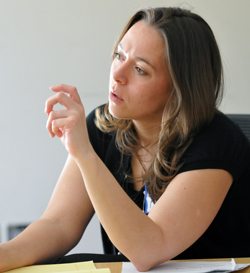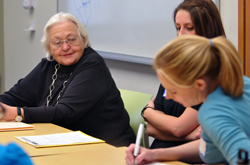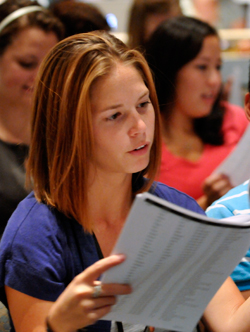Medical School Expands Interprofessional Education

By Tonia Twichell
(May 2, 2011) Dr. Mark Earnest uses a simple quiz to prove that medical school education needs to include students from other health specialties to improve safety and quality for patients.
It involves asking people to read a short paragraph about what sounds like a robbery. He asks participants to individually answer 18 questions about that
While some individuals answered as few as eight questions correctly, the teams scored much higher – nearly double in some cases.
Translate that to health care, where doctors, nurses, pharmacists
 “When I trained, there wasn’t anything mentioned about
“When I trained, there wasn’t anything mentioned about
At the medical campus, a giant step forward comes in the form of nearly $2 million in grants designed to kick start campus-wide, team-based learning.
Starting in February 2011, about 80 students from medicine, nursing, pharmacy, physical therapy
The teams will document the mentor’s medical history and engage in all aspects of the mentor’s health care over the next year.
In the fall, the program will expand to a two-year program that will include all first-year medical students working with students from the other schools and colleges. Other aspects of the grants from the Josiah Macy Jr. and Colorado Health foundations include TeamSTEPPS which teaches communication methods using simulated medical situations, and the Interprofessional Clinical Rotations Program.
The goal is to teach students to work in teams to improve patient care while they are still in school, in the hope that they will carry that over to their clinical practices.
Both Earnest and Foundations of Doctoring Curriculum Director Wendy Madigosky point to the 1999 Institute of Medicine report ‘To Err is Human’ as a “call to arms” for changes in the medical profession.
 “It said that as many as 100,000 people died every year due to medical errors,” Earnest says. “I thought, ‘That just can’t be true.’ But looking around and thinking about things, I realized that we often didn’t consider things that went wrong to be errors. It was simply the best that we could do in the circumstances and culture we worked in”
“It said that as many as 100,000 people died every year due to medical errors,” Earnest says. “I thought, ‘That just can’t be true.’ But looking around and thinking about things, I realized that we often didn’t consider things that went wrong to be errors. It was simply the best that we could do in the circumstances and culture we worked in”
Madigosky points out that there are essential communication modes that differ drastically between doctors and nurses.
“For example, in the hospitals, nurses and doctors write on different parts of the patient charts, and they don’t always know how to read each other’s notes. The doctor will tend to write the orders, but the nurses are more descriptive. They’ll write more about functionality. Doctors wouldn’t necessarily understand that.
“We need to move to a more common language. Nurses have a great communication technique called Situational Background Assessment Recommendation. They all know it. When they talk to a doctor, they may use SBAR, but the doctors don’t know SBAR. They don’t know it’s the nurses’ ‘cockpit language’ to explain something important. For nurses, it’s agreed-upon language, and they all use it.
“These are the kind of things we need to fix.”
 The idea that health care education had to change in order to improve patient care was already such an accepted concept when the Anschutz Medical Campus was built that it was designed by multi-disciplinary faculty task force to support team-based learning with shared classrooms and study rooms not just for professions, but also geared for subjects – Rural Health Care, Trauma Care, etc. The Carnegie Foundation for the Advancement of Teaching calls the campus ”a model of what an academic medical center should look like today.”
The idea that health care education had to change in order to improve patient care was already such an accepted concept when the Anschutz Medical Campus was built that it was designed by multi-disciplinary faculty task force to support team-based learning with shared classrooms and study rooms not just for professions, but also geared for subjects – Rural Health Care, Trauma Care, etc. The Carnegie Foundation for the Advancement of Teaching calls the campus ”a model of what an academic medical center should look like today.”
But changing the culture is still a challenge.
Scheduling, for example, can be a nightmare.
“If you ask nursing students to block out a three-hour chunk of time on a Wednesday afternoon for
“My goal is to graduate students who know this fundamentally, not just in their head, but with an almost instinctive ‘What am I a part of?’ reflection in their clinical roles. Not’ What do I do?’ But ‘What am I a part of?’” Earnest says. “That is not a part of health professionals’ thinking now.”
Graduation 2018

Read about our 2018 graduates and see the slide show of the celebration.
Related stories
- The School of Medicine is working with two campus hospitals to teach quality improvement
methods to students. - Students from all health disciplines are learning patient-centered health care through the Health Mentors Program.
- Students practice in a simulation lab at Anschutz Medical Campus to learn how to work together before entering a clinical setting
.
Quick Links:
- The AAMC announces new competencies and strategies for interprofessional education.
- For details about REACH, see the Josiah Macy Jr. Grant
that establishes the program at the Anschutz Medical Campus. - Read the summary from the Carnegie Foundation for the Advancement of Teaching which describes the Anschutz Medical Campus is a place that “fosters inter-professional education, patient care
and research.”